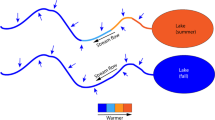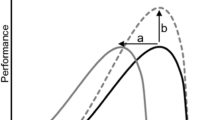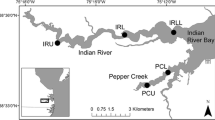Synopsis
Metabolic rates of seven fish species were used to assess the importance of temperature and dissolved oxygen as factors affecting longitudinal distributions of stream fish within California drainages. Metabolic rates of all species generally increased at higher acclimation temperatures and with abrupt temperature increases. In response to low dissolved oxygen, four species showed no change in metabolic rates up to a threshold temperature where hypoxia-induced metabolic depression was apparent. These threshold temperatures were near the lethal temperatures for each species. In contrast, two species showed metabolic depressions at every temperature, whereas one showed no depression at any temperature. In general, species occupying similar longitudinal positions in California streams behaved similarly in their metabolic responses. For most species, there was good correspondence between metabolic response and relevant field observations of occurrence. In cases where our analysis predicted species presence in waters where they did not exist, other abiotic factors, such as flow rate, or biotic factors, such as predation or competition, must be considered.
Similar content being viewed by others
References cited
Bainbridge, R. 1960. Speed and stamina in three fish. J. Exp. Biol. 37: 129–153
Bainbridge, R. 1962. Training, speed and stamina in trout. J. Exp. Biol. 39: 537–555
Baltz, D.M., P.B. Moyle & N.J. Knight. 1982. Competitive interactions between benthic stream fishes, riffle sculpin,Cottus gulosus and speckled dace,Rhinichthys osculus. Can. J. Fish. Aquat. Sci. 39: 1502–1511
Baltz, D.M., B. Vondracek, L.R. Brown & P.B. Moyle. 1987. Influence of temperature on microhabitat choice by fishes in a California stream. Trans. Amer. Fish. Soc. 116: 12–20
Cech, J.J., Jr. 1989. Respirometry.In: C.B. Schreck & P.B. Moyle
Cech, J.J., Jr., C.G. Campagna & S.J. Mitchell. 1979. Respiratory responses of largemouth bass (Micropterus salmoides) to environmental changes in temperature and dissolved oxygen. Trans. Amer. Fish. Soc. 108: 166–171
Clausen, R.G. 1936. Oxygen consumption in fresh water fishes. Ecology 17: 216–226
Cross, F.B. & L.M. Cavin. 1971. Effects of pollution, especially from feed lots, on fishes in the upper Neosha River basin. Contrib. No. 79, Kansas Water Resources Research Inst., Lawrence. 50 pp
Dickson, I.W. & R.H. Kramer. 1971. Factors influencing scope for activity and active and standard metabolism of rainbow trout (Salmo gairdneri). J. Fish. Res. Board Can. 28: 587–596
Fry, F.E.J. 1971. The effects of environmental factors on the physiology of fish. pp. 1–98.In: W.S. Hoar & D.J. Randall (ed.) Fish Physiology, Volume 6, Academic Press, New York
Gerking, S.D. 1980. Fish reproduction and stress. pp. 569–587.In: M.A. Ali (ed.) Environmental Physiology of Fishes, NATO Advanced Study Institutes Series A, Vol. 35. Plenum, New York
Gordon, M.S. 1968. Oxygen consumption of red and white muscles from tuna fishes. Science 159: 87–90
Heusner, A.A. 1982. Energy metabolism and body size. I. Is the 0.75 mass exponent of Kleiber's equation a statistical artifact? Resp. Physiol. 48: 1–12
Heusner, A.A. 1982. Energy metabolism and body size. II. Dimensional analysis and energetic non-similarity. Resp. Physiol. 48: 13–25
Heusner, A.A. 1984. Biological similitude: statistical and functional relationships in comparative physiology. Amer. J. Physiol. 246: (Reg. Integr. Comp. Physiol. 15): R839–845
Houston, A.H. 1982. Thermal effects upon fishes. Natural Research Council of Canada Publ. No. 18566. NRCC/CNRC Publications. Ottawa. 200 pp
Hynes, H.B.N. 1970. The ecology of running waters. Liverpool University Press, Liverpool. 555 pp
Kaya, C.M. 1978. Thermal resistance of rainbow trout from a permanently heated stream, and of two hatchery strains. Prog. Fish Cult. 40: 138–142
Lin, Y., G.H. Dobbs, III & A.L. DeVries. 1974. Oxygen consumption and lipid content in red and white muscles of Antarctic fishes. J. Exp. Zool. 189: 379–386
Matthews, W.J. 1987. Physicochemical tolerance and selectivity of stream fishes as related to their geographic ranges and local distributions. pp. 111–120.In: W.J. Matthews & D.C. Heins
Matthews, W.J. & J.T. Styron. 1981. Tolerance of headwater vs. mainstream fishes abrupt physicochemical changes. Amer. Midland Nat. 105: 149–153
Moyle, P.B. 1976. Inland fishes of California. University of California Press, Berkeley. 405 pp
Moyle, P.B. & D.M. Baltz. 1985. Microhabitat use by an assemblage of California stream fishes: developing criteria for instream flow determinations. Trans. Amer. Fish. Soc. 114: 695–704
Moyle, P.B. & H.W. Li. 1979. Community ecology and predator-prey relationships in warmwater streams. pp. 171–180.In: H. Clepper
Moyle, P.B. & R.D. Nichols. 1973. Ecology of some native and introduced fishes of the Sierra Nevada foothills in Central California. Copeia 1973: 478–490
Moyle, P.B., J.J. Smith, R.A. Daniels & D.M. Baltz. 1982. Distribution and ecology of stream fishes of the Sacramento San Joaquin drainage system, California — a review. Univ. California Publications in Zoology 115: 227–256
Neter, J., W. Wasserman & M.H. Kutner. 1985. Applied linear statistical models: regression, analysis of variance and experimental designs. Second Edition. Irwin, Homewood. 1127 pp
Ribarich, R.C. 1973. Factors affecting the spatial distribution of green sunfish and California roach in Tretton Creek, Fresno County, California. M.Sc. Thesis, California State University, Fresno. 57 pp
Smith, C.L. & C.R. Powell. 1971. The summer fish communities of Brier Creek, Marshall County, Oklahoma. Amer. Museum Novitates 2458: 1–30
Smith, J.J. 1977. Distribution, movements and ecology of the fishes of the Pajaro River system, California. Ph.D. Dissertation, University of California, Davis. 230 pp
Snedecor, G.W. & W.G. Cochran. 1967. Statistical methods. Iowa State University Press, Ames. 593 pp
Steel, R.G.D. & J.H. Torrie. 1960. Principles and procedures of statistics. McGraw Hill, New York. 481 pp
Taylor, J.N., W.R. Courtenay, Jr. & J.A. McCann. 1984. Known impacts of exotic fishes in the continental United States. pp. 322–373.In: W.R. Courtenay, Jr. & J.R. Stauffer, Jr.
Ultsch, G.R., H. Boschung & M.J. Ross. 1978. Metabolism, critical oxygen tension, and habitat selection in darters (Etheostoma). Ecology 59: 99–107
Wales, J.H. 1950. Swimming speed of the western sucker,Catostomus occidentalis Ayres. California Fish and Game 36: 433–434
Author information
Authors and Affiliations
Rights and permissions
About this article
Cite this article
Cech, J.J., Mitchell, S.J., Castleberry, D.T. et al. Distribution of California stream fishes: influence of environmental temperature and hypoxia. Environ Biol Fish 29, 95–105 (1990). https://doi.org/10.1007/BF00005026
Received:
Accepted:
Issue Date:
DOI: https://doi.org/10.1007/BF00005026




